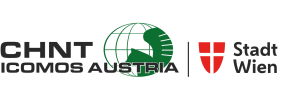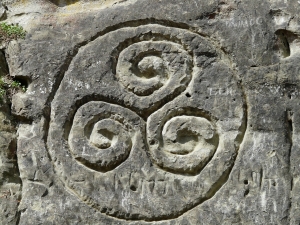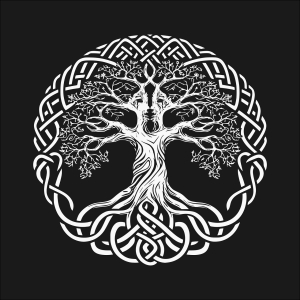Loss of Identity and Changing Meanings – Intangible Heritage and Extremist groups
An introduction
When we talk about heritage, we often think of the very tangible and solid cultural objects that are seen as emblematic of a particular group. The symbols and their meanings are less to the forefront despite being an equally important part of heritage – they are merely more intangible and in their own way so much more fragile than the objects, buildings and so on that we seek to protect from time and modern life.
Intangible heritage such as symbols is highly subject to memory, to (dis)use and to record keeping. A symbol can become lost within a short time due to the lack of transmitted information (cf. Chisungu symbols meanings, which may have had a particular set of meanings initially or at some point, but who can’t be defined with certainty by those involved in the rituals (Richards, 1982 (1956))). Information about a symbol can be biased or uncertain for any number of reasons. The ability to record and preserve meaning has changed over time and whether or not it was deemed necessary to record a meaning may impact whether or not it was preserved accurately for a given value of accuracy.
One of the significant factors to consider in relation to that preservation of intangible heritage such as symbols is the (re)assigning and (re)imagining of meaning in the context of internet activity, archive building and dissemination of concepts and interpretations. The internet changes the speed and range of this movement of symbols and their perceived meanings into something far less containable and restrained. Distortions and alterations can take place with the involvement of a seemingly boundless number of participants with endless amounts of cultural inputs and concepts.
Meaning cannot be expected to remain fixed and static no matter the medium of transmission and as such, changing meanings of symbols is not an inherently modern phenomenon or only due to the option of rapid and boundless communication through the internet. However, with modern technology, certain more harmful distortions and appropriations of symbols can become a far more wide-reaching phenomenon with far less restraint than ever before. This is a significant consideration in relation to the preservation of that intangible heritage.
Ancient symbols are adopted readily by various groups to present a sense of validity and aura of factuality to their cause/agenda. Whether it is a neopagan group such as Ár nDraíocht Féin (ADF) adopting the heraldry of a Scottish clan (Furth, 2010) or white supremacist groups such as Identity Evropa adopting classical statues (Morse, 2018), this appropriation (be it positive, neutral or negative) changes the understanding of the symbol used. Whilst a positive or neutral appropriation only creates a distortion/shift of meaning and association, negative appropriation creates an association that can engender a potential destruction of heritage for those to whom that symbol originally belongs.
The overlap of associations can become such that the symbol becomes lost to its original meaning – the examples of interest in this instance are Celtic crosses, runes, the Valknut, Thor’s Hammer and such similar elements from the Celto-Nordic cultures that have been particularly adopted by Far-Right groups (Global Project Against Hate and Extremism, 2023A) (Global Project Against Hate and Extremism, 2023B) (Mas, 2021) (Anti Defamation League, 2023). These symbols have a meaning that predates their adoption by white supremacists and also have current competing meanings particularly within Neopagan communities and with those who happen to be descendants of the cultural groups to which they belonged originally.
The visibility of one meaning versus another is highly dependent on how much weight is given to each and the more negative meanings and appropriations make use of the internet to overwhelm and erase the original and competing meanings, the more that intangible heritage is lost and destroyed, leaving their cultural roots weakened and poorer for it.
Bibliography
Anti Defamation League. (2023, February 21). Thor’s Hammer. Retrieved November 12, 2023, from ADL: https://www.adl.org/resources/hate-symbol/thors-hammer
Furth, B. H. (2010). Celtic Symbols, Celtic Identities: A Folk Historical Analysis of Symbols in Celtic Ethnopagan Traditions. 109th Annual Meeting of American Anthropological Association. New Orleans: American Anthropological Association.
Global Project Against Hate and Extremism. (2023A, June 26). Celtic Cross. Retrieved November 12, 2023, from Global Extremist Symbols Database: https://symbols.globalextremism.org/details?recordId=recRMhx3i1R2UMidb
Global Project Against Hate and Extremism. (2023B, June 26). Valknut. Retrieved from Global Extremist Symbols Database: https://symbols.globalextremism.org/details?recordId=recRwaHe31e9o6K3Z
Mas, L. (2021, January 8). Auschwitz, QAnon, Viking tattoos: the white supremacist symbols sported by rioters who stormed the Capitol. Retrieved November 12, 2023, from France24 – The Observers: https://observers.france24.com/en/americas/20210108-white-supremacist-symbols-us-capitol
Morse, H. (2018, February 15). Classics and the Alt-Right: Historicizing Visual Rhetories of White Supremacy. Retrieved October 2023, from University of Michigan – College of Literature, Science and the Arts: https://sites.lsa.umich.edu/learn-speak-act/2018/02/15/classics-and-the-alt-right/
Richards, A. I. (1982 (1956)). Chisungu – A girl’s inititation ceremony among the Bemba of Zambia. Routledge.
Celtic Cross style stone grave marker
Image by Monika from Pixabay
Stone engraving of a Triskele
Image by Hans from Pixabay
Drawing of Yggdrasil
Image by Quin Benson from Pixabay






